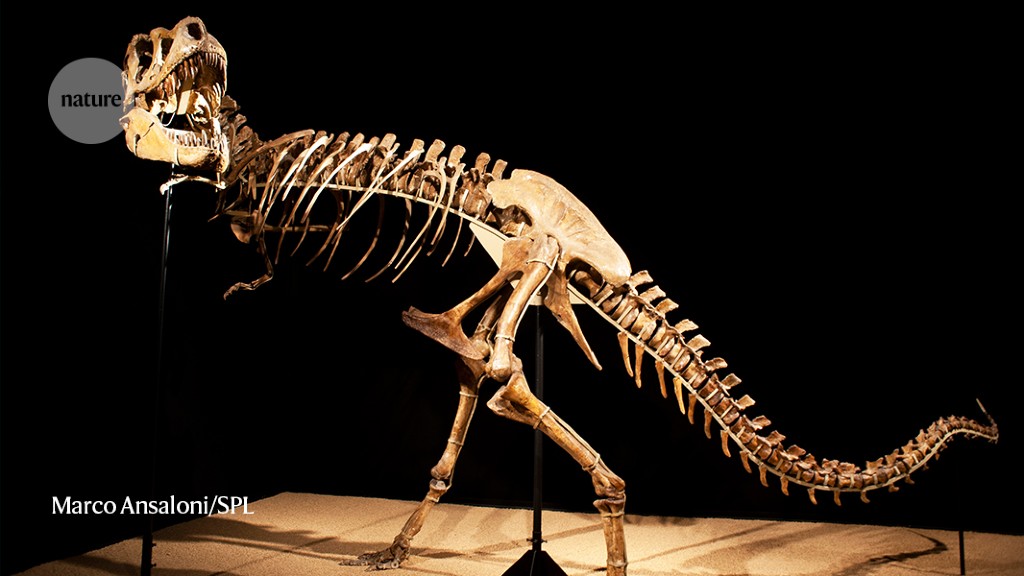Theropod dinosaurs such as Tarbosaurus bataar grew large or small in a range of ways.Credit: Marco Ansaloni/SPL
A sweeping analysis of shin bones has given researchers a glimpse into how some dinosaurs evolved into mega-beasts such as Tyrannosaurus, and others into smaller, bird-like creatures. The work, published this week in Science1, reveals that dinosaurs used more than one evolutionary trick to become larger — or smaller — over time.
Prevailing wisdom held that large-bodied animals are bigger than their smaller-bodied relatives because they grow faster during their most rapid period of growth. That trend holds true for modern animals including birds and mammals — elephants and ostriches grow faster than chihuahuas and sparrows, for example.
It’s not the case for all animals. Crocodiles and alligators, for instance, become large because they grow for a long time. But palaeontologists had assumed that for theropod dinosaurs — a group that includes the iconic T. rex and which spawned modern birds — large species got big through rapid growth spurts. “It’s kind of become the established idea in dinosaurs,” says palaeontologist Michael D’Emic at Adelphi University in Garden City, New York.
But that’s not what D’Emic found when he sawed into the bones of Majungasaurus, a 7-metre-long T. rex relative that lived 66 million years ago on what is now Madagascar. The speed of growth in dinosaurs is recorded in rings laid down each year in their bones. Instead of seeing wide rings corresponding to a rapid adolescent growth spurt, D’Emic found lots of narrow growth rings, suggesting that Majungasaurus had become large over a prolonged period.
“I was very surprised,” he says. The next dinosaur he examined, a similar-sized beast called Ceratasaurus, was the opposite — a big dinosaur that grew fast during its growth spurt, says D’Emic.
Bone growth rings
Over a decade, D’Emic and his colleagues amassed bone growth-ring measurements from 42 theropod species to see which strategies led to large and small bodies. They found that 31% of theropod species were larger than their ancestors because of faster growth and 28% because of prolonged growth. Meanwhile, 21% became smaller than their ancestors by shortening their growth spurts, and 19% by slowing growth.
The study covered theropod species that lived between 230 million years ago and the end of the Cretaceous period 66 million years ago, when a mass-extinction event wiped out the non-avian dinosaurs. It’s “a huge evolutionary timescale”, to include in an analysis, says Vera Weisbecker, an evolutionary biologist at Flinders University in Adelaide, Australia. “That is really impressive,” she says. “It’s just fascinating that there are so many developmental ways to become big or small.”
Palaeontologist Kevin Padian at the University of California, Berkeley, says the analysis is the kind of work that needs to be done, animal group by animal group, to understand how body size evolves.
Drivers of change
But Meike Köhler, an evolutionary palaeobiologist at the Catalan Institution for Research and Advanced Studies in Barcelona, Spain, says the findings are not surprising because previous work has shown a range of growth strategies across animal species. Köhler would like to see an analysis that considers what ecological circumstances influenced how animals changed in size over time.
Weisbecker says that the growth strategy used might be related to evolutionary pressures. “If you looked at all the ones with explosive early growth, you might be able to test if they happen to be the ones that are more likely to be predated on, for example,” she says.
For each species, the growth strategy that led to its individual body size probably related to its unique environment, says Padian. “It’s not a one-size-fits-all, which is a good thing for us to learn,” he says. “We might have thought that, but they’ve documented it.”
D’Emic says he and his team are conducting similar analyses on other groups, including mammals — a group that contains many more species to sample — to see whether the diversity is found in other branches of the evolutionary tree.








More News
Author Correction: Stepwise activation of a metabotropic glutamate receptor – Nature
Changing rainforest to plantations shifts tropical food webs
Streamlined skull helps foxes take a nosedive